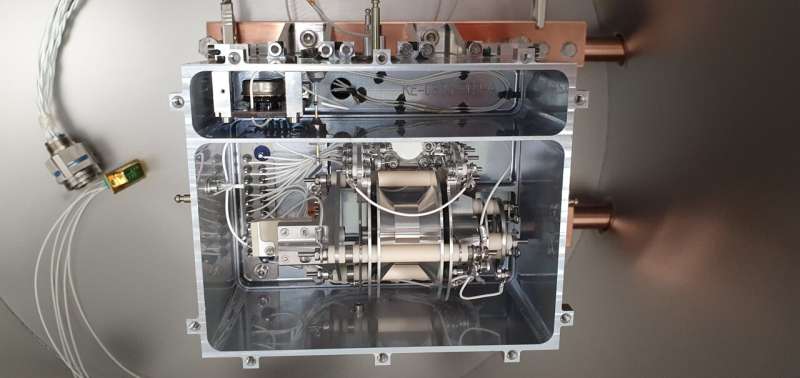Credit: The Open University
The heart of the Exospheric Mass Spectrometer (EMS) is visible in this image of the key sensor that will study the abundance of lunar water and water ice for upcoming missions to the Moon.
This spectrometer is being delivered to NASA today as part of the PITMS instrument for its launch to the Moon later this year.
EMS is based on an 'ion trap', an ingenious detector device that allows researchers to identify and quantify sample atoms and molecules in a gas and allows to establish a corresponding mass spectrum. Scientists at The Open University and RAL Space are developing EMS under an ESA contract.
Lunar molecules entering the sensor are bombarded by electrons emitted by a heated wire to create ions. The resulting ions are stored within an electric field formed by a set of precisely-shaped electrodes. The ions are then released from this 'trap' in order of increasing mass/charge ratio into the detector that identifies and quantifies their chemical makeup.
This will allow the instrument to measure water and other molecules in the very thin atmosphere of the Moon throughout the lunar day to study a lunar 'water cycle' concept.
The PITMS instrument will be part of a lunar lander that will arrive on the Moon on NASA's Astrobotic M1 mission taking commercial lunar payloads to the Lacus Mortis region in 2021.
A similar Mass Spectrometer is also developed for ESA's Prospect payload package to study lunar water ice on board the Russian Luna-27 lander, set for launch in 2025. The platform will sample potential resources on the Moon to prepare technologies for future sustainable exploration.
"ESA's Exospheric Mass Spectrometer will not only acquire science data but also test our latest environmental monitoring technology for planetary environments," says Roland Trautner, ESA project lead for EMS.
"Instruments like EMS allow the detection of the impact of human activities on the lunar environment, and understanding these changes allows us to improve our science and learn how to protect the natural environment on planetary bodies. Small, lightweight detectors like EMS might become standard equipment on future lunar landers."
With the goal of developing the first long-term presence on the Moon, ESA is joining forces with NASA and other partners on humanity's return to the Moon. The next 'Artemis' generation to experience lunar landings will be an international one and is opening up lunar space exploration to the global population.
Provided by European Space Agency
























